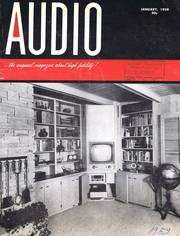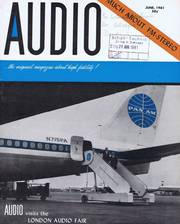Erläuterungen zu diesen US-AUDIO Seiten der 1950er Jahre
Die hier stehenden amerikanischen Artikel aus 1959 (aus der US-AUDIO) sind teilweise sehr gewöhnungsbedürftig, weil sie erstens aus einer längst vergangenen Zeit stammen und zweitens, weil dort in den USA ganz "anders" gedacht wurde als bei uns in Old Germany oder in Europa.
Vergleichbar mit unseren deutschen Hifi-Magazinen etwa ab 1962 ist jedoch, daß auch dieses Audio-Magazin ihre Anzeigen- Kunden und -Leser am Markt oder von anderen Magazinen (be- oder ab- ?) werben mußte. - Weiterhin sind die riesigen Dimensionen des amerikanischen Kontinents mit unseren hier in Europa nicht vergleichbar. - Ein Redaktions-"Trip" von New York nach Los Angeles oder Chicago oder gar in die Wüste nach Las-Vegas zu einer der CES- Audio- "Shows" war - auch mit dem Flugzeug - immer noch eine halbe Weltreise. Und jede Ausstellung oder "Messe" wurde als "Show" deklariert. Und natürlich, in USA musste alles "Show" sein, um beim Publikum einige Aufmerksamkeit zu erzeugen.
In Deutschland West hatten wir 1961 immer noch andere Sorgen
Wir hatten zwar bereits den UKW Rundfunk, damit wir nach dem Kopenhagener Wellenplan überhaupt wieder Rundfunk empfangen konnten, aber das wars erstmal. Die Rundfunkanstalten der ARD waren irgendwie mit dem Fernsehen arg beschäftigt und wer brauchte schon dieses Stereo ? Die "Leute" könn(t)en ja Stereo-Platten kaufen, wenn sie Stereo haben wollten. Keiner hat kommen sehen, daß die Fortentwicklung des Konsumenten-Marktes und der Freizeit-Gesellschaft dieses überflüssige und befremdliche "Stereo" über den Sender auch bei uns in nur wenigen Jahren erzwingen würde.
.
In der US-AUDIO 06/1961 folgt jetzt dieser detaillierte Artikel :
"Was hat die "F.C.C."-Behörde da geschmiedet ?"
Original-Überschrift : "What Hath FCC Wrought ?" - Ein sehr interessanter Artikel mit vielen technischen Erklärungen von DAVID SASLAW
Voraus zu schicken ist noch, daß in einem anderen Artikel erklärt wurde, daß die F.C.C. diese neuen "harten" Vorgaben als "Befehl" (order) an alle Beteiligten und Interessenten ausgegeben hatte.
Das waren also keine "Vorschläge" oder "Empfehlungen" oder Ähnliches (wie zum Beispiel unsere spätere 45.500 Hifi-Norm), das war in USA von sofort an Gesetz.
.
After several years of study, the FCC has finally decided upon a system of FM stereo. The system approved has the capability of achieving fidelity as high as is now available with monophonic FM broadcasts. Here are some details :
.
Zur der Entscheidung der FCC für dieses Stereo-Konzept:
On APRIL 20th of this year (1961), the FCC made known its decision to permit FM stereo broadcasting commencing June 1. 1961
The decision, although actively sought for many years, seems to have caught many people by surprise. The surprise does not center about multiplexing as such, but rather the system chosen by the FCC.
On the one hand there have been comments implying that the chosen system is "not as good" as one of the systems not chosen. On the other hand, there have been comments to the effect that many FM tuners were rendered "obsolete" because of the FCC decision.
Actually these reactions are quite natural considering the enthusiasm with which particular systems were championed and the unusual lack of factual information about the system chosen.
At this point it might be well to point out that the Zenith-GE system performed as well as the best of the systems not selected, and in addition is essentially more flexible (able to retain the existing commercial FM multiplex, SCA) than the runner-up system (Crosby).
As for the fear that some types of tuners would be unable to be adapted to stereo operation, this is just not so. More about both of these points later.
Exactly : What Is the New Stereo System?
First of all it should be noted that the FCC merely established what is to be transmitted (also das Sendesignal), not how it is to be achieved (und nicht wie es zu erreichen geht). In essence, what was approved was a basic equation which defines the signal to be transmitted (for the exact equation see the Daniel von Recklinghausen article on page 21). In addition, the FCC defined the transmission standards for this basic signal in order to ensure high quality broadcasts (from a technical viewpoint).
Die (in USA gesetzlich zwingenden) FCC Vorgaben im Einzelnen
Following is the section of FCC Docket (Dokument) 13506 wherein the transmission standards are defined:
§ 3.322 Stereophonic Transmission Standards.
.
- (a) The modulating signal for the main channel shall consist of the sum of the left and right signals.
- (b) A pilot subearrier at 19,000 cycles plus or minus 2 cycles shall be transmitted that shall frequency modulate the main carrier between the limits of 8 and 10 per cent.
- (c) The stereophonic subearrier shall be the second harmonic of the pilot subearrier and shall cross the time axis with a positive slope simultaneously with each crossing of the time axis by the pilot subearrier.
- (d) Amplitude modulation of the stereophonic subearrier shall be used.
- (e) The stereophonic subearrier shall be suppressed to a level less than one per cent modulation of the main carrier.
- (f) The stereophonic subearrier shall be capable of accepting audio frequencies from 50 to 15,000 cycles.
- (g) The modulating signal for the stereophonic subearrier shall be equal to the difference of the left and right signals.
- (h) The pre-emphasis characteristics of the stereophonic subchannel shall be identical with those of the main channel with respect to phase and amplitude at all frequencies.
- (i) The sum of the side bands resulting from amplitude modulation of the stereophonic subearrier shall not cause a peak deviation of the main carrier in excess of 45 per cent of total modulation (excluding SCA subcarriers) when only a left (or right) signal exists; simultaneously in the main channel, the deviation when only a left (or right) signal exists shall not exceed 45 per cent of total modulation (excluding SCA subcarriers).
- (j) Total modulation of the main carrier including pilot subearrier and SCA subcarriers shall meet the requirements of Section 3.268 with maximum modulation of the main carrier by all SCA subcarriers limited to 10 per cent.
- (k) At the instant when only a positive left signal is applied, the main channel modulation shall cause an upward deviation of the main carrier frequency; and the stereophonic subearrier and its sidebands signal shall cross the time axis simultaneously and in the same direction.
- (l) The ratio of peak main channel deviation to peak stereophonic subchannel deviation when only a steady state left (or right) signal exists shall be within plus or minus 3.5 per cent of unity for all levels of this signal and all frequencies from 50 to 15,000 cycles.
- (m) The phase difference between the zero points of the main channel signal and the stereophonic subearrier sidebands envelope, when only a steady state left (or right) signal exists, shall not exceed plus or minus 3 degrees for audio modulating frequencies from 50 to 15,000 cycles.
- (n) Crosstalk into the main channel caused by a signal in the stereophonic subchannel shall be attenuated at least 40 decibels below 90 per cent modulation.
- (o) Crosstalk into the stereophonic subchannel caused by a signal in the main channel shall be attenuated at least 40 decibels below 90 per cent modulation.
- (p) For required transmitter performance, all of the requirements of Section 3.254 shall apply with the exception that the maximum modulation to be employed is 90 per cent (excluding pilot subearrier) rather than 100 per cent.
- (q) For electrical performance standards of the transmitter and associated equipment, the requirements of Section 3.317 (a) (2),(3), (4) and (5) shall apply to the main channel and stereophonic subchannel alike, except that where 100 per cent modulation is referred to, this figure shall include the pilot subcarrier.
.
- Anmerkung : Die Entscheidung der FFC (Behörde) hat in USA Gesetzeskraft. Demnach darf ab dem 1. Juli kein anderes Stereo-System (in einem öffentlichen Sender !!) mehr betrieben oder in Betrieb genommen werden. Ausschließlich diese von der FCC abgesegnete Version war gesetzeskonform.
.
Broadcasting FM Stereo
Previously we indicated that the FCC had approved the form and the technical standards for the stereo signal, not how it would be achieved. The distinction is quite significant. For instance, the approved system is known as the GE-Zenith system. Both GE and Zenith have on file with the FCC diagrams of proposed methods for producing the signal in the desired form.
Both diagrams happen to be essentially similar as to method of signal generation. (Compare Fig. 1 in this article with Fig. 1 in the article by Csicsatka and Linz, page 24.) Does this mean that this method must be used by all broadcasters ?
Definitely not.
There are at least two fundamentally different methods for achieving the standard signal. One of them is the type illustrated by GE and Zenith and described in the Csicsatka and Linz article, the other system is described at length in the von Recklinghausen article.
To summarize the two methods, the GE-Zenith technique requires a matrix wherein the sum and difference signals are achieved. The sum signal is fed to the FM exciter after a suitable time delay (to keep it in step with the difference signal which follows a somewhat different path).
The difference signal, on the other hand, goes through a 38,000cps suppressed carrier AM modulator and then to the FM exciter. Of course, both the sum and difference signals are properly pre-emphasized (before the matrix in the GE diagram, after in the Zenith), and the difference signal is filtered to eliminate the harmonics of the carrier.
Figure 2 shows the block diagram of an AM modulator (Zenith proposal) which will generate the 15,000-cps-wide sidebands around the 38,000-cps carrier (which is suppressed) and, at the same time, provide the 19,000-cps pilot signal. The method used in this modulator is to mix the output of two crystal oscillators to provide the 38,000-cps carrier, or, by a 2/1 division, the 19,000 cps pilot. The pilot is then added to the sidebands which remain after the carrier is suppressed and the combined signal passed through a linear-phase-shift low-pass filter. If we refer back to the FCC specifications we note that the maximum difference permitted between the main and subchannel is 3 degrees. For this reason, care had to be exercised to avoid introduction of unwanted phase shift.
This is especially true in a system such as this wherein the paths for the main and subchannel are not identical.
On the other hand, the second method for generation of the standard signal is far less critical as to phase shift. This system is a time-division multiplex switching system between left and right stereophonic program channels.
In this system a switching device alternately takes the whole left or the whole right signal. In a way it is rather difficult to understand how switching rapidly between the two inputs will produce the standard equation, but the fact of the matter is that it does produce it.
In actuality, the form of the standard equation is the key to its derivation; it is essentially a Fourier expansion of two variables. That is, if we were to take any two independent variables and expand them mathematically we would arrive at substantially the same equation.
According to Carl Eilers of Zenith Radio Corp. (who worked on it), the idea for the now accepted system had its inception through mathematical analysis of the time-division multiplex signal.
Strangely enough, in its own presentation, Zenith did not propose this method of signal generation. Instead they proposed the system shown in Fig. 1. As far as we know at present, H.H.Scott, Inc. is the only proponent of the time-division method of signal generation on a practical basis; they have announced the availability of equipment utilizing this principle.
Although on the surface this method is much more sophisticated from an engineering viewpoint, it is quite possible that the matrixing method is much easier to integrate with existing equipment.
Most likely this is the reason most of the emphasis has been placed on the matrixing method. It is also possible that the time-division method is not as well known as it should be.
.
Receiving FM Stereo - 2 fundamental unterschiedliche Methoden
Just as there are two fundamentally different methods for transmitting the stereo signal, there are an equal number of methods for receiving it. It might be said that these methods are "mirror images" of the transmission systems; they essentially reverse the procedure of the broadcast station.
For example, let us consider the matrixing method. The sum signal is derived from a matrix and, except for some normal processing, is transmitted in that form. Referring to the block diagram of the GE adapter (Fig. 2 in the Csicsatka and Linz article) we can see that the receiver just reverses this process.
The difference signal, however must first be recovered from the sidebands in which it was transmitted. This involves reinserting the 38,000cps carrier which was suppressed at the transmitter and then separating the audio from the carrier.
In order to reinsert the carrier precisely where it should be, the 19,000cps pilot is used; either to synchronize a local 38,000cps oscillator or directly in a doubler circuit. We know that this pilot will give us the precise time location we need since it was transmitted with the signal. Then we can demodulate.
.
The difference signal is now ready for matrixing to recover the original left and right signals which started the whole process.
The switching (time-division) method, used in the receiver, is a "mirror image" of the time-division transmission method although there are several ways of effecting the time division.
Figure 3 is the block diagram of the method used by Zenith and H.H.Scott uses another method as shown in Fig. 4 of the von Recklinghausen article.
In both cases the switching is synchronized by a 38,000cps signal derived from the 19,000cps pilot. The H.H.Scott adapter is explained in detail by Mr. von Recklinghausen.
A schematic of the Zenith adapter is given in Fig. 4. In reality very little explanation is necessary for this system once the time-division method of generation is clear; the receiver is only required to switch between signals at the precise rate used in broadcasting to reverse the process and extend the original left and right signals. The switching rate (as explained by von Recklinghausen) is 38,000cps, the second harmonic of the pilot signal.
The natural question now is whether the matrix receiver will operate with a signal generated by the time-division method and vice versa. The answer to this, of course, is that the signal generated by both the matrixing and time-division methods is exactly the same in the air; the receiver sees the same signal no matter which method is used to generate it.
I must admit, however, that to date I have never actually "heard" the time-division method (I did attend a demonstration of the matrixing method), but then how many people have?
Existing Equipment
Now to return to the apprehensions expressed by some people about the forced obsolescence of some existing tuners. Apparently it was felt that tuners that use Foster-Seely type discriminators would be unable to be adapted.
The reality of the situation is that there is no valid technical reason for this fear. It has been stated that discriminators of the Foster-Seely type are inherently too narrow in bandwidth to handle FM stereo transmission, a situation made more difficult by the fact that in stereophonic transmission more energy is concentrated near the edges of the passband than heretofore.
In fact, a well-designed FM tuner, whether it uses a ratio detector or Foster-Seely discriminator, can have a sufficiently wide bandwidth to handle stereophonic transmission under the rules adopted. The key words here are "well-designed."
Certainly a poorly designed tuner with a discriminator will probably yield unacceptable distortion with stereophonic signals. But the fact of the matter is that such a tuner will provide distorted monophonic signals too.
A poorly designed FM tuner, even with a ratio detector, will also provide unacceptable distortion. This whole matter can be summed up by noting that a high-quality tuner will provide a high-quality signal, whereas a poor-quality unit will distort - no matter what system of FM detection is used. In other words, the existing high-quality FM tuner is not obsolete.
Is the Monophonic Signal Degraded?
In our enthusiasm for the marvels of FM stereo, we tend to overlook the fact that many people will want to continue receiving monophonic FM programs for some time. Will they "pay the piper" for those who wish to have stereo now.
In other words, is the monophonic signal degraded? The answer is no - and in fact this was one of the important reasons for selecting the GE-Zenith system.
.
Conclusion / Zusammenfassung
Clearly the public has been served by this FCC decision - it not only preserves the existing monophonic transmission, but in addition provides the new dimension of stereo.
Our title paraphrases the statement made at the inauguration of the telephone which uschered in a new era. I trust this decision by the FCC may be as momentous for FM broadcasting.
Ein Artikel aus der US-AUDIO vom Juni 1961
.



